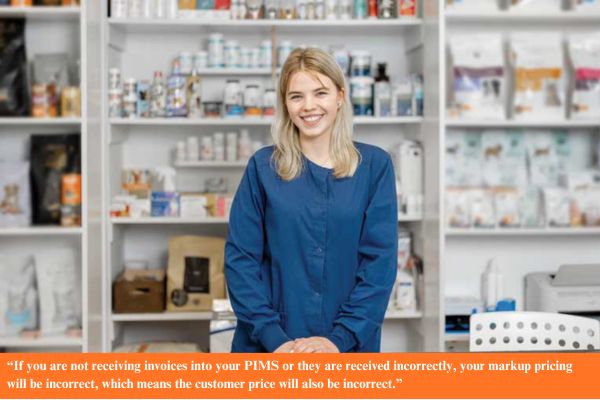When managing inventory, there are variables to be considered in order to maintain a profitable pharmacy and ensure you are charging correctly for the value of your services. Ultimately, your pricing should be based on profit potential, demographics, clinic location, and industry benchmarks while also considering ordering costs, holding costs, a profit and hard costs.
With that, many practice managers and owners may not have a full understanding of the basics and importance of margin and markup pricing. Learning more about those can help the clinic recover from costs of expensive medication and provide better patient care.
Markup pricing
Markup pricing is the most popular choice in pricing inventory, which tends to focus on the cost of the unit when determining the selling price and is generally the easiest to use for most companies to calculate.
The product is expressed as a percentage and is usually set equally across the board for different categories. A few examples of categories would be injectables, antibiotics, dietary, OTC, and preventatives.
When setting pricing, consider using a turnover report to help set your percentage of markup. For example, the more times an item turns (sells), the lower the markup is typically, and vice versa. The lower turnover items usually have a higher markup to cover the cost of the product as it generally expires prior to using its entirety.
When using markup pricing, some practice inventory management software (PIMS) can be set to automatically update the price, so when the cost increases, the PIMS will adjust the customers pricing, which makes your life so much easier!
Another thing to consider is, with pet owners price shopping, try to keep up with the competitive market. In the end, you want clients purchasing medications from your facility, so make sure to price shop at least once a year.
However, there are a few downfalls to using markup pricing. For one, if you are not receiving invoices into your PIMS or they are received incorrectly, your markup pricing will be incorrect, which means the customer price will also be incorrect. Another downfall is price sensitivity. With pet owners shopping around for medications, your pricing may be astronomical compared to competitors. Some businesses will sometimes overlook operational costs when setting pricing, so you want to make sure your pricing is effectively covering the value of your services. Some of these costs can include shipping, rents, and wages, among others, which in the end, has the practice focusing on increasing profits versus cutting costs.
Margin pricing
Margin pricing focuses on the cost of the product, plus a desired profit margin to arrive at its selling point. It is a more straightforward pricing strategy, especially for products with high costs. Say you have an injectable antibiotic that costs $350 per bottle. If you set it up on markup pricing to 45 percent per ml, more than likely, a lot of your larger dogs/animals will decline treatment because it will be too expensive. This is where margin pricing can come into play. Establish a base cost and a desired profit margin to ensure you are covering all costs. Again, you want to make sure you are including your ordering and holding costs on top of your product cost and desired profit. Some examples of categories that would be suited for margin pricing are laboratory services, vaccines, some injectables, and surgery services.
A disadvantage to margin pricing is it calls for a more frequent evaluation as it does not automatically update on PIMS as the costs increase. I usually recommend evaluating your pricing strategy for margin pricing at least quarterly, which means more work.
There is also no one “magic” gross margin to aim for as it varies with each product. In the end, you want to make sure you price it accordingly to recover your costs vs. the product being declined and eventually losing out on revenue because you never use it and then it expires.
Let’s face it: there are some great products your veterinarians believe in, but the markup pricing sometimes becomes the barrier for patients to receive recommended treatment.
The price tag for better patient care
So how do you know which products are suited for markup pricing and which ones are suited for margin pricing? How does it tie into the delivery of better patient care?
For more expensive products it may be recommended to use margin pricing, structuring it where the cost for extra-large animals will be around the same price for smaller patients, no matter the amount of medication pulled.
For example, an injectable antibiotic set on markup pricing will cost an arm and a leg for a bull mastiff versus a Pomeranian. When a price is too expensive, this could deter patients from receiving the recommended treatment.
Flipping it to margin pricing, the treatment may be more affordable. Say your cost is $40 per injection, add a lower margin price for extra-large patients and a higher margin price for smaller patients. This will allow clients to access and accept the recommended treatment for their pets. Plus, it also helps the practice recover the cost of the product.
By giving the smaller animals a higher margin price and larger animals a smaller margin price no matter how much product is used, it pretty much evens out and allows pet owners to have access to the same treatment without breaking the bank.
Once you have a better understanding of markup and margin pricing, you can then restructure your inventory to be able to provide the most adequate treatment by ensuring each pet has equal access to the same medications.
One thing to keep in mind is, not every practice will have the same markup or margin pricing because in the end, it is dependent on the competitive market and growth goals within your practice. Understanding the difference between the two will help your practice maintain growth by ensuring your costs are adequately covered all while being able to provide better patient care overall.
Rachel Singletary is a previous practice manager who has worked in many different areas of veterinary hospitals. Her top passions are inventory, staff development, budgeting, OSHA regulations, and controlled drug record keeping. Singletary enjoys writing and studying new topics in her free time. She is located in Lakeland, Fla.




